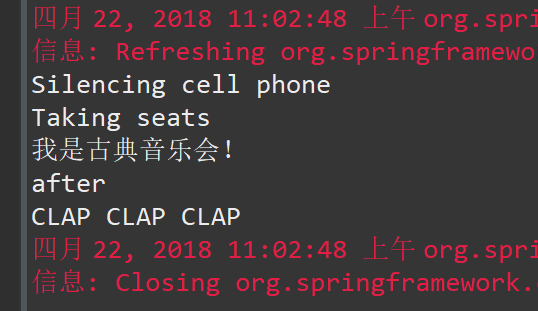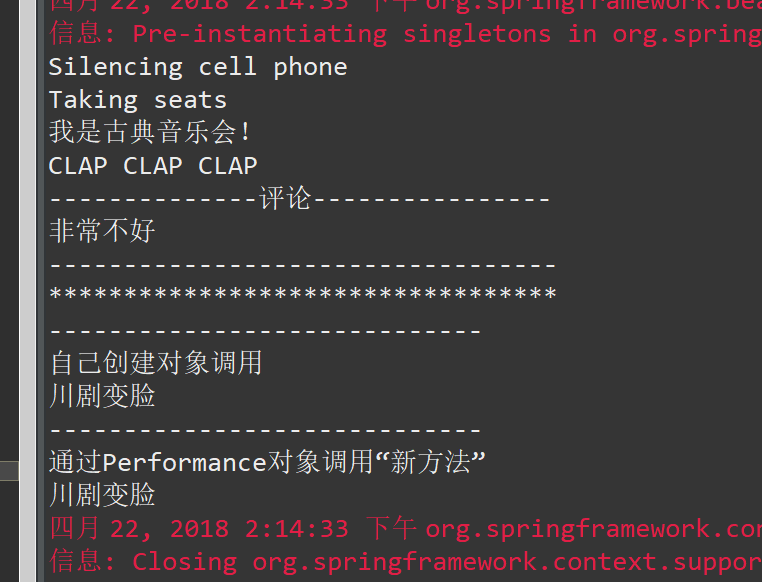AOP中 @Before @After @AfterThrowing@AfterReturning的执行顺序
1 public Object invoke(Object proxy, Method method, Object[] args) throws Throwable { 2 Object result; 3 try { 4 //@Before 5 result = method.invoke(target, args); 6 //@After 7 return result; 8 } catch (InvocationTargetException e) { 9 Throwable targetException = e.getTargetException(); 10 //@AfterThrowing 11 throw targetException; 12 } finally { 13 //@AfterReturning 14 } 15 }
以Audience为例,代码如下:
1 package concert; 2 3 import org.aspectj.lang.annotation.After; 4 import org.aspectj.lang.annotation.AfterReturning; 5 import org.aspectj.lang.annotation.AfterThrowing; 6 import org.aspectj.lang.annotation.Aspect; 7 import org.aspectj.lang.annotation.Before; 8 import org.aspectj.lang.annotation.Pointcut; 9 import org.springframework.stereotype.Component; 10 11 @Aspect 12 @Component 13 public class Audience { 14 @Pointcut("execution(* concert.Performance.perform(..))") 15 public void performs() { 16 17 } 18 19 @Before("performs()") 20 public void silenceCellPhones() { 21 System.out.println("Silencing cell phone"); 22 } 23 24 @Before("performs()") 25 public void takeSeats() { 26 System.out.println("Taking seats"); 27 } 28 29 @After("performs()") 30 public void after() { 31 System.out.println("after"); 32 } 33 34 @AfterReturning("performs()") 35 public void applause() { 36 System.out.println("CLAP CLAP CLAP"); 37 } 38 39 @AfterThrowing("performs()") 40 public void demandRefund() { 41 System.out.println("Demanding a refund"); 42 } 43 }
执行结果:

注入AspectJ切面 (新)
1.将原来的观众类定义为一个真正的切面,Audience.java 将观众的行为都放在这个切面中,然后在spring中引用这个切面,并且为这个切面注入新的方法,具体可参照笔记12。
1 package concert4; 2 3 public aspect Audience { 4 public Audience(){} 5 pointcut performance():execution(* perform(..)); 6 7 before():performance(){ 8 System.out.println("Silencing cell phone"); 9 } 10 before():performance(){ 11 System.out.println("Taking seats"); 12 } 13 after():performance(){ 14 System.out.println("CLAP CLAP CLAP"); 15 } 16 after()returning :performance(){ 17 System.out.println("--------------评论----------------"); 18 System.out.println(criticismEngine.getCriticism()); 19 System.out.println("----------------------------------"); 20 } 21 22 private CriticismEngine criticismEngine; 23 24 public void setCriticismEngine(CriticismEngine criticismEngine){ 25 this.criticismEngine=criticismEngine; 26 } 27 }
2.修改XML配置文件
1 <?xml version="1.0" encoding="UTF-8"?> 2 <beans xmlns="http://www.springframework.org/schema/beans" 3 xmlns:xsi="http://www.w3.org/2001/XMLSchema-instance" 4 xmlns:aop="http://www.springframework.org/schema/aop" 5 xmlns:tx="http://www.springframework.org/schema/tx" 6 xmlns:context="http://www.springframework.org/schema/context" 7 xmlns:c="http://www.springframework.org/schema/c" 8 xsi:schemaLocation=" 9 http://www.springframework.org/schema/beans 10 http://www.springframework.org/schema/beans/spring-beans-3.0.xsd 11 http://www.springframework.org/schema/aop 12 http://www.springframework.org/schema/aop/spring-aop-3.0.xsd 13 http://www.springframework.org/schema/tx 14 http://www.springframework.org/schema/tx/spring-tx-3.0.xsd 15 http://www.springframework.org/schema/context 16 http://www.springframework.org/schema/context/spring-context-3.0.xsd"> 17 18 <bean class="concert4.Classcial"></bean> 19 <bean id="criticismEngine" class="concert4.CriticismEngineTmpl"> 20 <property name="criticismPool"> 21 <list> 22 <value>不好</value> 23 <value>很不好</value> 24 <value>非常不好</value> 25 </list> 26 </property> 27 </bean> 28 <bean id="audience" class="concert4.Audience" factory-method="aspectOf"> 29 <property name="criticismEngine" ref="criticismEngine"></property> 30 </bean> 31 <aop:config> 32 <aop:aspect ref="audience"> 33 <aop:declare-parents types-matching="concert4.Performance+" 34 implement-interface="concert4.Encoreable" 35 default-impl="concert4.DefaultEncoreable"/> 36 </aop:aspect> 37 </aop:config> 38 39 </beans>
3.结果
